Hospitality Business Toolkit Report: Mandarin Oriental Analysis
VerifiedAdded on 2023/01/12
|16
|4363
|53
Report
AI Summary
This report examines the Hospitality Business Toolkit, focusing on the Mandarin Oriental Hyde Park hotel. It covers financial performance management principles, including documentation, timeliness, consistency, and justification. The report details the double-entry bookkeeping system, ledger accounts, and trial balance preparation. It also analyzes the HR life cycle stages, including recruitment, onboarding, and exit strategies. A performance management plan is outlined for a specific hospitality job role, along with an exploration of relevant employment legislation and its impact on business decisions. The report concludes with an overview of the interrelation of functional roles, communication methods, and coordination within the hospitality sector, providing a comprehensive analysis of key business operations and strategies.
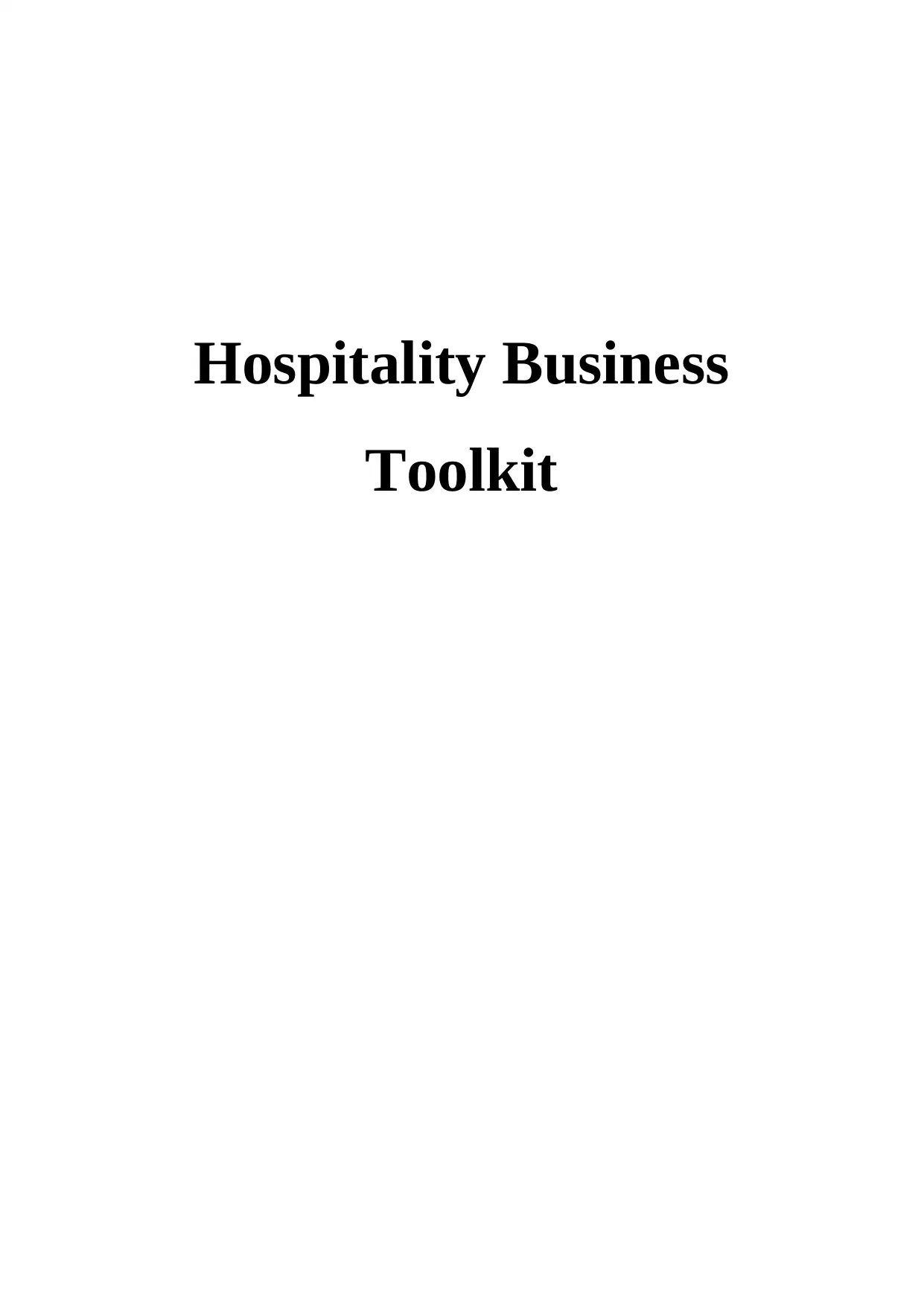
Hospitality Business
Toolkit
Toolkit
Paraphrase This Document
Need a fresh take? Get an instant paraphrase of this document with our AI Paraphraser
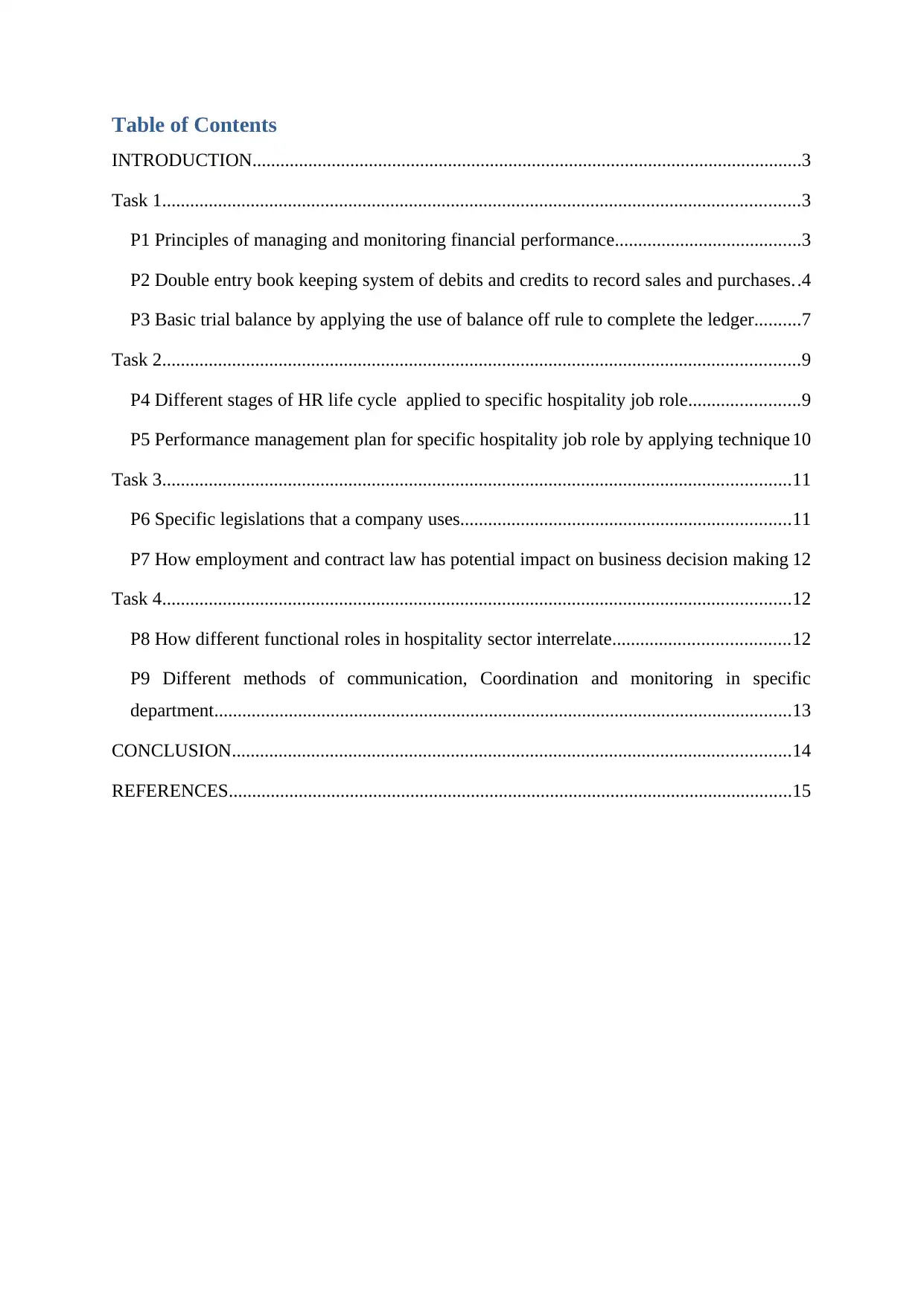
Table of Contents
INTRODUCTION......................................................................................................................3
Task 1.........................................................................................................................................3
P1 Principles of managing and monitoring financial performance........................................3
P2 Double entry book keeping system of debits and credits to record sales and purchases..4
P3 Basic trial balance by applying the use of balance off rule to complete the ledger..........7
Task 2.........................................................................................................................................9
P4 Different stages of HR life cycle applied to specific hospitality job role........................9
P5 Performance management plan for specific hospitality job role by applying technique 10
Task 3.......................................................................................................................................11
P6 Specific legislations that a company uses.......................................................................11
P7 How employment and contract law has potential impact on business decision making 12
Task 4.......................................................................................................................................12
P8 How different functional roles in hospitality sector interrelate......................................12
P9 Different methods of communication, Coordination and monitoring in specific
department............................................................................................................................13
CONCLUSION........................................................................................................................14
REFERENCES.........................................................................................................................15
INTRODUCTION......................................................................................................................3
Task 1.........................................................................................................................................3
P1 Principles of managing and monitoring financial performance........................................3
P2 Double entry book keeping system of debits and credits to record sales and purchases..4
P3 Basic trial balance by applying the use of balance off rule to complete the ledger..........7
Task 2.........................................................................................................................................9
P4 Different stages of HR life cycle applied to specific hospitality job role........................9
P5 Performance management plan for specific hospitality job role by applying technique 10
Task 3.......................................................................................................................................11
P6 Specific legislations that a company uses.......................................................................11
P7 How employment and contract law has potential impact on business decision making 12
Task 4.......................................................................................................................................12
P8 How different functional roles in hospitality sector interrelate......................................12
P9 Different methods of communication, Coordination and monitoring in specific
department............................................................................................................................13
CONCLUSION........................................................................................................................14
REFERENCES.........................................................................................................................15
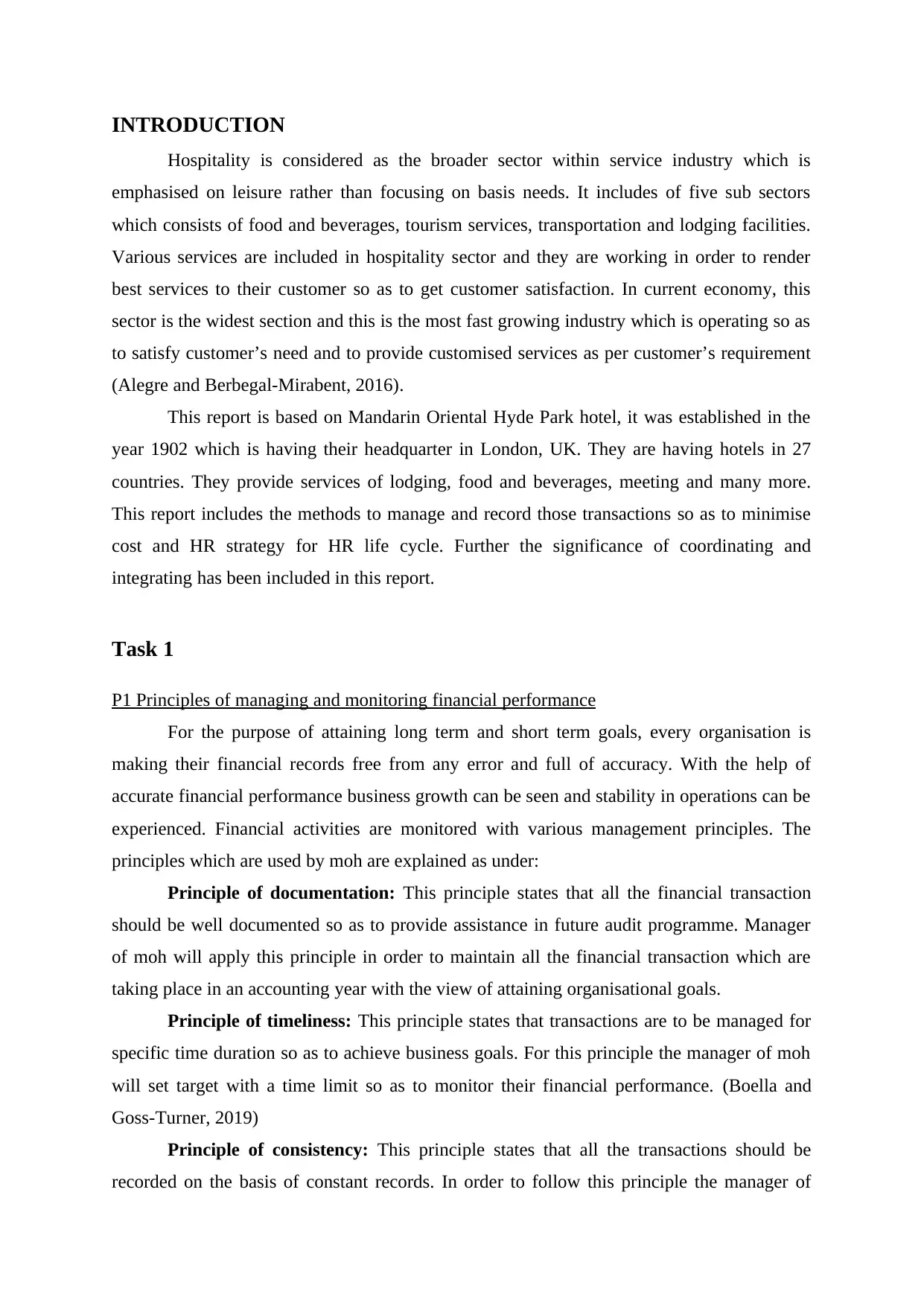
INTRODUCTION
Hospitality is considered as the broader sector within service industry which is
emphasised on leisure rather than focusing on basis needs. It includes of five sub sectors
which consists of food and beverages, tourism services, transportation and lodging facilities.
Various services are included in hospitality sector and they are working in order to render
best services to their customer so as to get customer satisfaction. In current economy, this
sector is the widest section and this is the most fast growing industry which is operating so as
to satisfy customer’s need and to provide customised services as per customer’s requirement
(Alegre and Berbegal-Mirabent, 2016).
This report is based on Mandarin Oriental Hyde Park hotel, it was established in the
year 1902 which is having their headquarter in London, UK. They are having hotels in 27
countries. They provide services of lodging, food and beverages, meeting and many more.
This report includes the methods to manage and record those transactions so as to minimise
cost and HR strategy for HR life cycle. Further the significance of coordinating and
integrating has been included in this report.
Task 1
P1 Principles of managing and monitoring financial performance
For the purpose of attaining long term and short term goals, every organisation is
making their financial records free from any error and full of accuracy. With the help of
accurate financial performance business growth can be seen and stability in operations can be
experienced. Financial activities are monitored with various management principles. The
principles which are used by moh are explained as under:
Principle of documentation: This principle states that all the financial transaction
should be well documented so as to provide assistance in future audit programme. Manager
of moh will apply this principle in order to maintain all the financial transaction which are
taking place in an accounting year with the view of attaining organisational goals.
Principle of timeliness: This principle states that transactions are to be managed for
specific time duration so as to achieve business goals. For this principle the manager of moh
will set target with a time limit so as to monitor their financial performance. (Boella and
Goss-Turner, 2019)
Principle of consistency: This principle states that all the transactions should be
recorded on the basis of constant records. In order to follow this principle the manager of
Hospitality is considered as the broader sector within service industry which is
emphasised on leisure rather than focusing on basis needs. It includes of five sub sectors
which consists of food and beverages, tourism services, transportation and lodging facilities.
Various services are included in hospitality sector and they are working in order to render
best services to their customer so as to get customer satisfaction. In current economy, this
sector is the widest section and this is the most fast growing industry which is operating so as
to satisfy customer’s need and to provide customised services as per customer’s requirement
(Alegre and Berbegal-Mirabent, 2016).
This report is based on Mandarin Oriental Hyde Park hotel, it was established in the
year 1902 which is having their headquarter in London, UK. They are having hotels in 27
countries. They provide services of lodging, food and beverages, meeting and many more.
This report includes the methods to manage and record those transactions so as to minimise
cost and HR strategy for HR life cycle. Further the significance of coordinating and
integrating has been included in this report.
Task 1
P1 Principles of managing and monitoring financial performance
For the purpose of attaining long term and short term goals, every organisation is
making their financial records free from any error and full of accuracy. With the help of
accurate financial performance business growth can be seen and stability in operations can be
experienced. Financial activities are monitored with various management principles. The
principles which are used by moh are explained as under:
Principle of documentation: This principle states that all the financial transaction
should be well documented so as to provide assistance in future audit programme. Manager
of moh will apply this principle in order to maintain all the financial transaction which are
taking place in an accounting year with the view of attaining organisational goals.
Principle of timeliness: This principle states that transactions are to be managed for
specific time duration so as to achieve business goals. For this principle the manager of moh
will set target with a time limit so as to monitor their financial performance. (Boella and
Goss-Turner, 2019)
Principle of consistency: This principle states that all the transactions should be
recorded on the basis of constant records. In order to follow this principle the manager of
⊘ This is a preview!⊘
Do you want full access?
Subscribe today to unlock all pages.

Trusted by 1+ million students worldwide
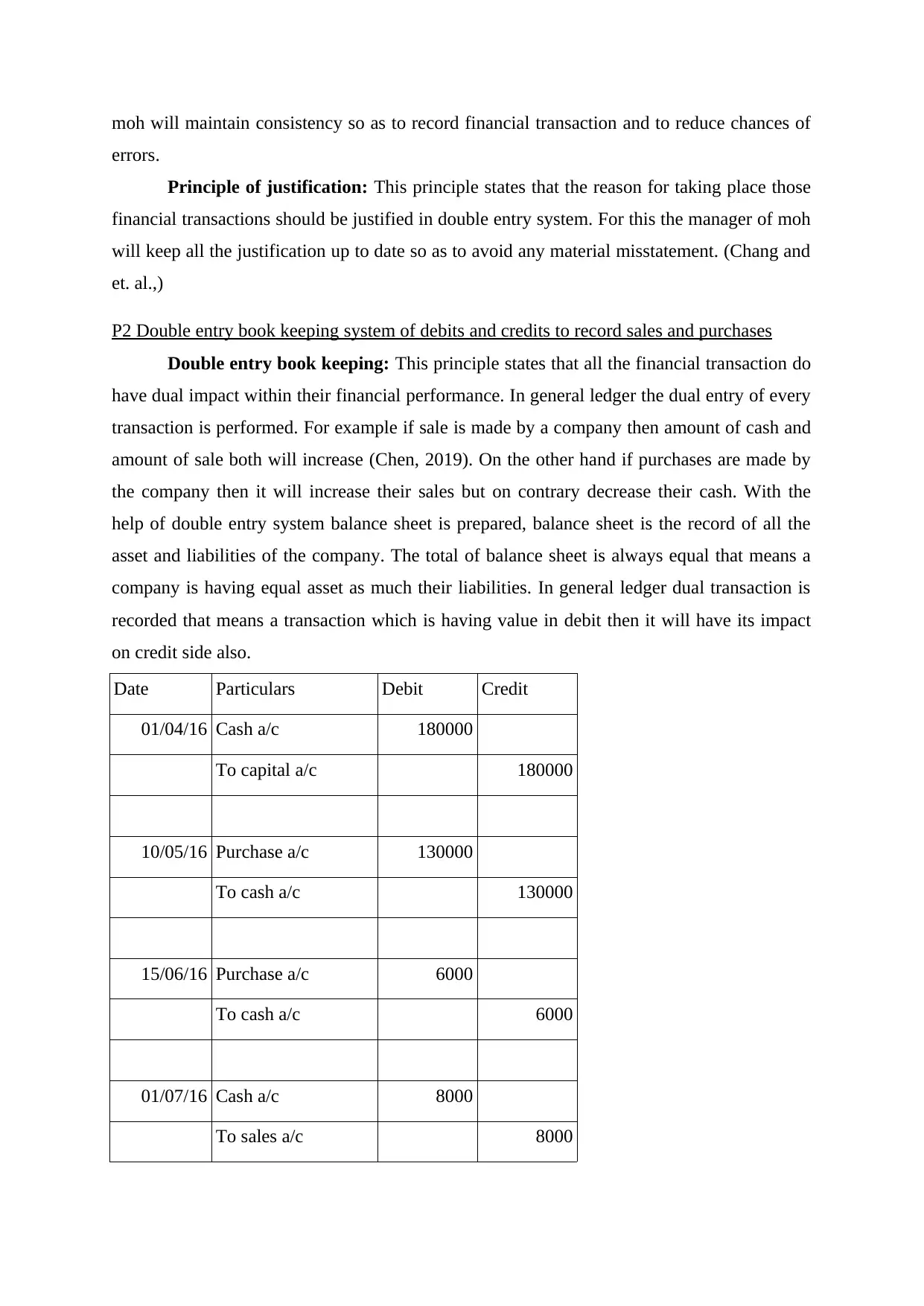
moh will maintain consistency so as to record financial transaction and to reduce chances of
errors.
Principle of justification: This principle states that the reason for taking place those
financial transactions should be justified in double entry system. For this the manager of moh
will keep all the justification up to date so as to avoid any material misstatement. (Chang and
et. al.,)
P2 Double entry book keeping system of debits and credits to record sales and purchases
Double entry book keeping: This principle states that all the financial transaction do
have dual impact within their financial performance. In general ledger the dual entry of every
transaction is performed. For example if sale is made by a company then amount of cash and
amount of sale both will increase (Chen, 2019). On the other hand if purchases are made by
the company then it will increase their sales but on contrary decrease their cash. With the
help of double entry system balance sheet is prepared, balance sheet is the record of all the
asset and liabilities of the company. The total of balance sheet is always equal that means a
company is having equal asset as much their liabilities. In general ledger dual transaction is
recorded that means a transaction which is having value in debit then it will have its impact
on credit side also.
Date Particulars Debit Credit
01/04/16 Cash a/c 180000
To capital a/c 180000
10/05/16 Purchase a/c 130000
To cash a/c 130000
15/06/16 Purchase a/c 6000
To cash a/c 6000
01/07/16 Cash a/c 8000
To sales a/c 8000
errors.
Principle of justification: This principle states that the reason for taking place those
financial transactions should be justified in double entry system. For this the manager of moh
will keep all the justification up to date so as to avoid any material misstatement. (Chang and
et. al.,)
P2 Double entry book keeping system of debits and credits to record sales and purchases
Double entry book keeping: This principle states that all the financial transaction do
have dual impact within their financial performance. In general ledger the dual entry of every
transaction is performed. For example if sale is made by a company then amount of cash and
amount of sale both will increase (Chen, 2019). On the other hand if purchases are made by
the company then it will increase their sales but on contrary decrease their cash. With the
help of double entry system balance sheet is prepared, balance sheet is the record of all the
asset and liabilities of the company. The total of balance sheet is always equal that means a
company is having equal asset as much their liabilities. In general ledger dual transaction is
recorded that means a transaction which is having value in debit then it will have its impact
on credit side also.
Date Particulars Debit Credit
01/04/16 Cash a/c 180000
To capital a/c 180000
10/05/16 Purchase a/c 130000
To cash a/c 130000
15/06/16 Purchase a/c 6000
To cash a/c 6000
01/07/16 Cash a/c 8000
To sales a/c 8000
Paraphrase This Document
Need a fresh take? Get an instant paraphrase of this document with our AI Paraphraser
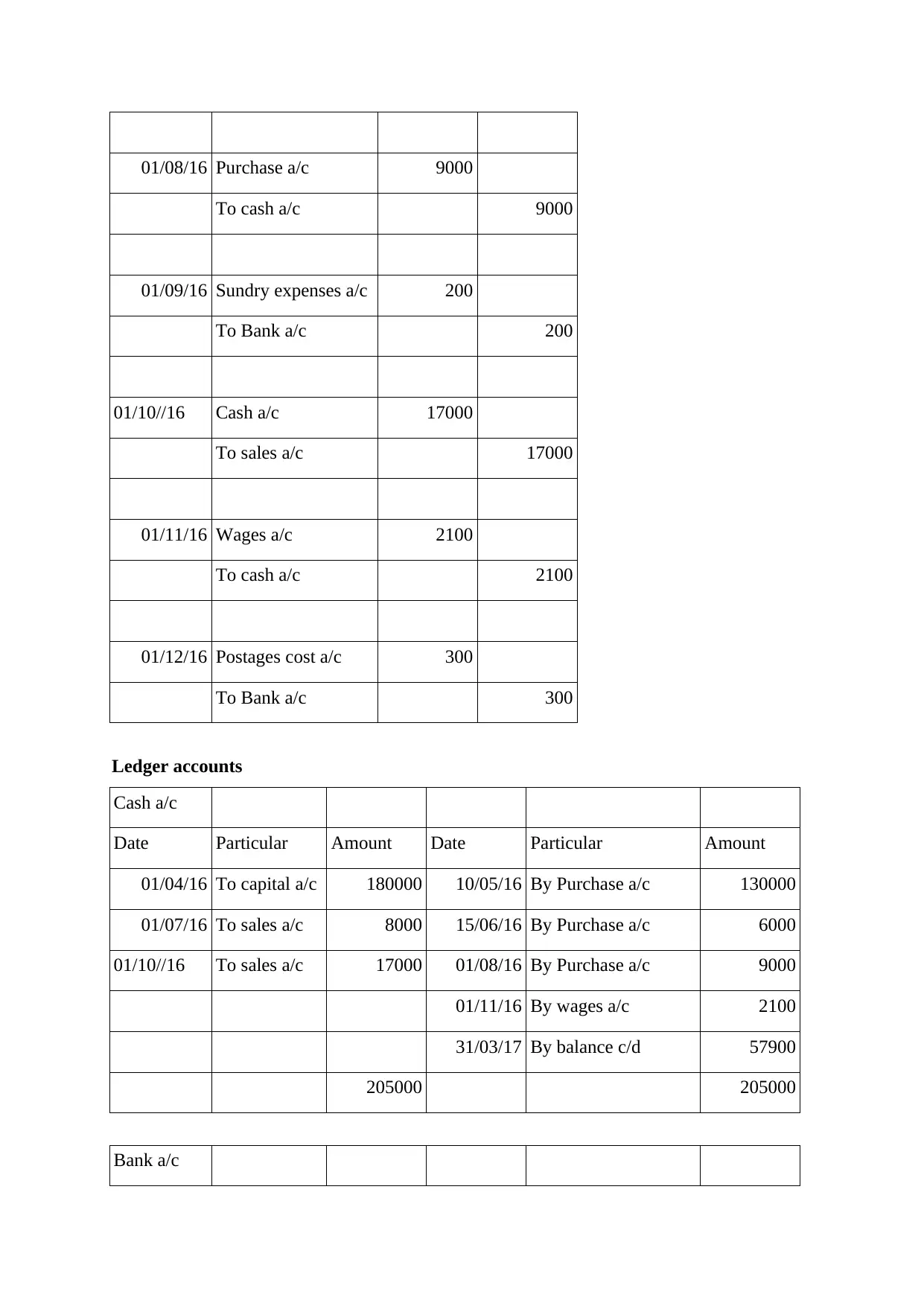
01/08/16 Purchase a/c 9000
To cash a/c 9000
01/09/16 Sundry expenses a/c 200
To Bank a/c 200
01/10//16 Cash a/c 17000
To sales a/c 17000
01/11/16 Wages a/c 2100
To cash a/c 2100
01/12/16 Postages cost a/c 300
To Bank a/c 300
Ledger accounts
Cash a/c
Date Particular Amount Date Particular Amount
01/04/16 To capital a/c 180000 10/05/16 By Purchase a/c 130000
01/07/16 To sales a/c 8000 15/06/16 By Purchase a/c 6000
01/10//16 To sales a/c 17000 01/08/16 By Purchase a/c 9000
01/11/16 By wages a/c 2100
31/03/17 By balance c/d 57900
205000 205000
Bank a/c
To cash a/c 9000
01/09/16 Sundry expenses a/c 200
To Bank a/c 200
01/10//16 Cash a/c 17000
To sales a/c 17000
01/11/16 Wages a/c 2100
To cash a/c 2100
01/12/16 Postages cost a/c 300
To Bank a/c 300
Ledger accounts
Cash a/c
Date Particular Amount Date Particular Amount
01/04/16 To capital a/c 180000 10/05/16 By Purchase a/c 130000
01/07/16 To sales a/c 8000 15/06/16 By Purchase a/c 6000
01/10//16 To sales a/c 17000 01/08/16 By Purchase a/c 9000
01/11/16 By wages a/c 2100
31/03/17 By balance c/d 57900
205000 205000
Bank a/c
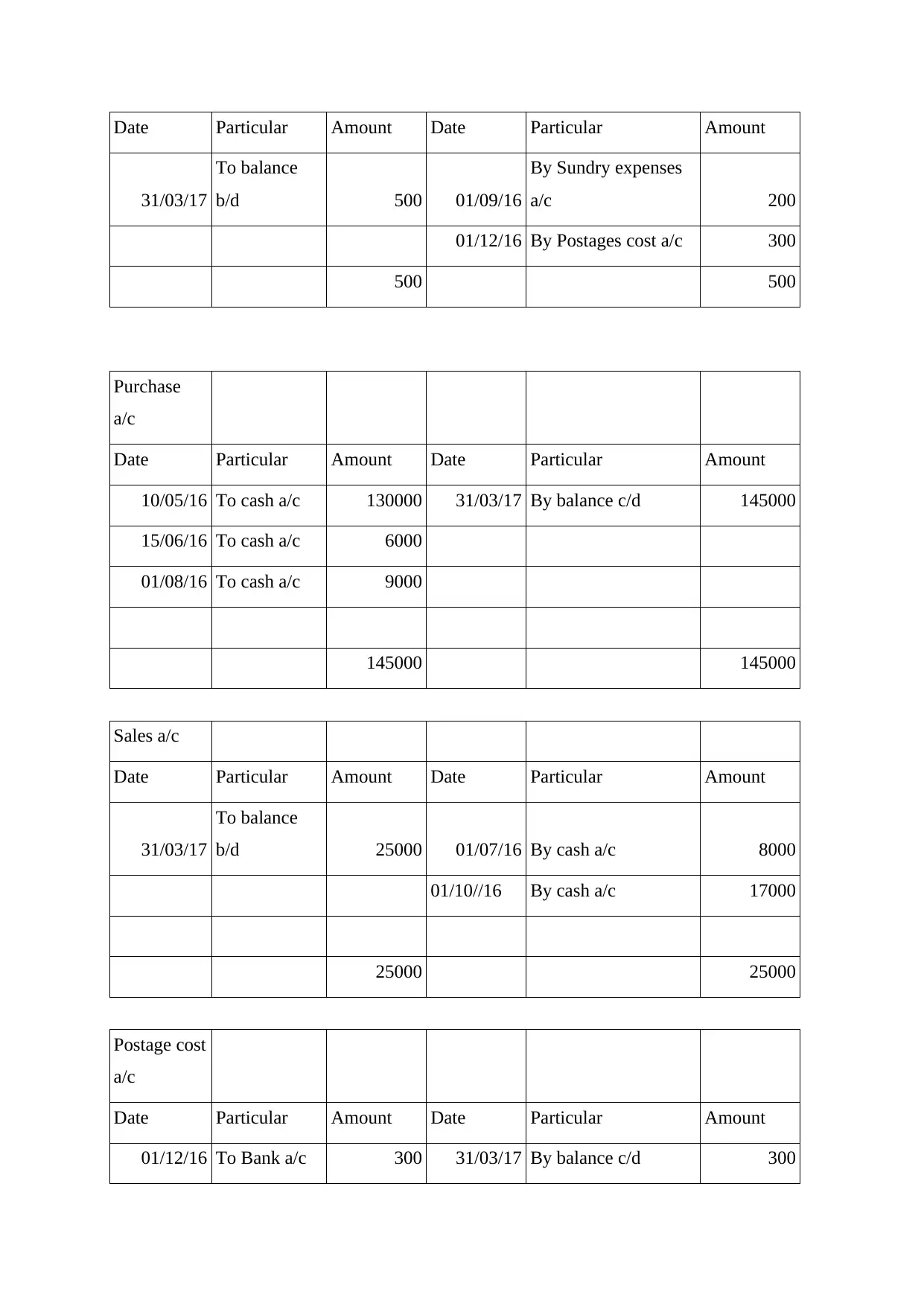
Date Particular Amount Date Particular Amount
31/03/17
To balance
b/d 500 01/09/16
By Sundry expenses
a/c 200
01/12/16 By Postages cost a/c 300
500 500
Purchase
a/c
Date Particular Amount Date Particular Amount
10/05/16 To cash a/c 130000 31/03/17 By balance c/d 145000
15/06/16 To cash a/c 6000
01/08/16 To cash a/c 9000
145000 145000
Sales a/c
Date Particular Amount Date Particular Amount
31/03/17
To balance
b/d 25000 01/07/16 By cash a/c 8000
01/10//16 By cash a/c 17000
25000 25000
Postage cost
a/c
Date Particular Amount Date Particular Amount
01/12/16 To Bank a/c 300 31/03/17 By balance c/d 300
31/03/17
To balance
b/d 500 01/09/16
By Sundry expenses
a/c 200
01/12/16 By Postages cost a/c 300
500 500
Purchase
a/c
Date Particular Amount Date Particular Amount
10/05/16 To cash a/c 130000 31/03/17 By balance c/d 145000
15/06/16 To cash a/c 6000
01/08/16 To cash a/c 9000
145000 145000
Sales a/c
Date Particular Amount Date Particular Amount
31/03/17
To balance
b/d 25000 01/07/16 By cash a/c 8000
01/10//16 By cash a/c 17000
25000 25000
Postage cost
a/c
Date Particular Amount Date Particular Amount
01/12/16 To Bank a/c 300 31/03/17 By balance c/d 300
⊘ This is a preview!⊘
Do you want full access?
Subscribe today to unlock all pages.

Trusted by 1+ million students worldwide
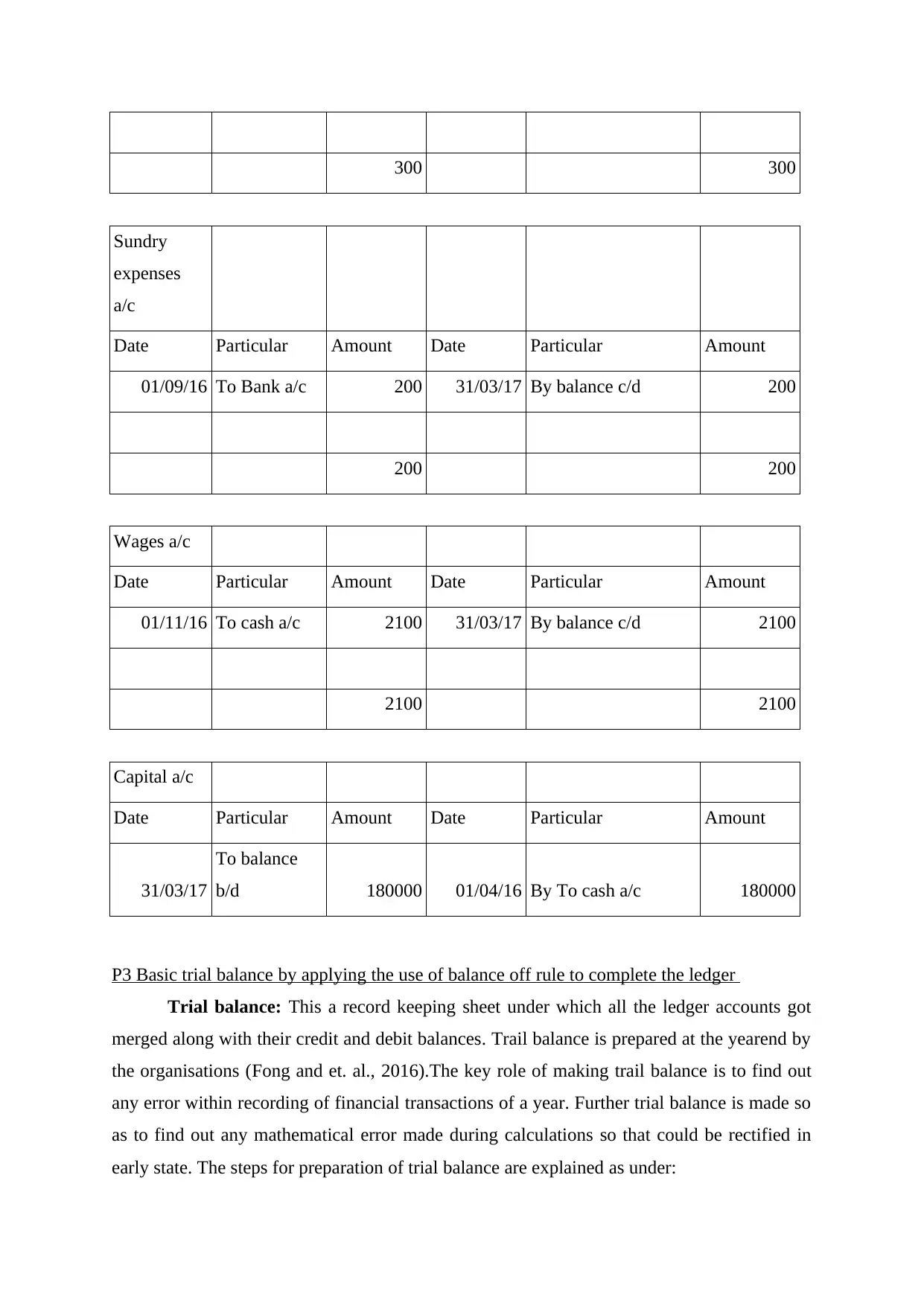
300 300
Sundry
expenses
a/c
Date Particular Amount Date Particular Amount
01/09/16 To Bank a/c 200 31/03/17 By balance c/d 200
200 200
Wages a/c
Date Particular Amount Date Particular Amount
01/11/16 To cash a/c 2100 31/03/17 By balance c/d 2100
2100 2100
Capital a/c
Date Particular Amount Date Particular Amount
31/03/17
To balance
b/d 180000 01/04/16 By To cash a/c 180000
P3 Basic trial balance by applying the use of balance off rule to complete the ledger
Trial balance: This a record keeping sheet under which all the ledger accounts got
merged along with their credit and debit balances. Trail balance is prepared at the yearend by
the organisations (Fong and et. al., 2016).The key role of making trail balance is to find out
any error within recording of financial transactions of a year. Further trial balance is made so
as to find out any mathematical error made during calculations so that could be rectified in
early state. The steps for preparation of trial balance are explained as under:
Sundry
expenses
a/c
Date Particular Amount Date Particular Amount
01/09/16 To Bank a/c 200 31/03/17 By balance c/d 200
200 200
Wages a/c
Date Particular Amount Date Particular Amount
01/11/16 To cash a/c 2100 31/03/17 By balance c/d 2100
2100 2100
Capital a/c
Date Particular Amount Date Particular Amount
31/03/17
To balance
b/d 180000 01/04/16 By To cash a/c 180000
P3 Basic trial balance by applying the use of balance off rule to complete the ledger
Trial balance: This a record keeping sheet under which all the ledger accounts got
merged along with their credit and debit balances. Trail balance is prepared at the yearend by
the organisations (Fong and et. al., 2016).The key role of making trail balance is to find out
any error within recording of financial transactions of a year. Further trial balance is made so
as to find out any mathematical error made during calculations so that could be rectified in
early state. The steps for preparation of trial balance are explained as under:
Paraphrase This Document
Need a fresh take? Get an instant paraphrase of this document with our AI Paraphraser
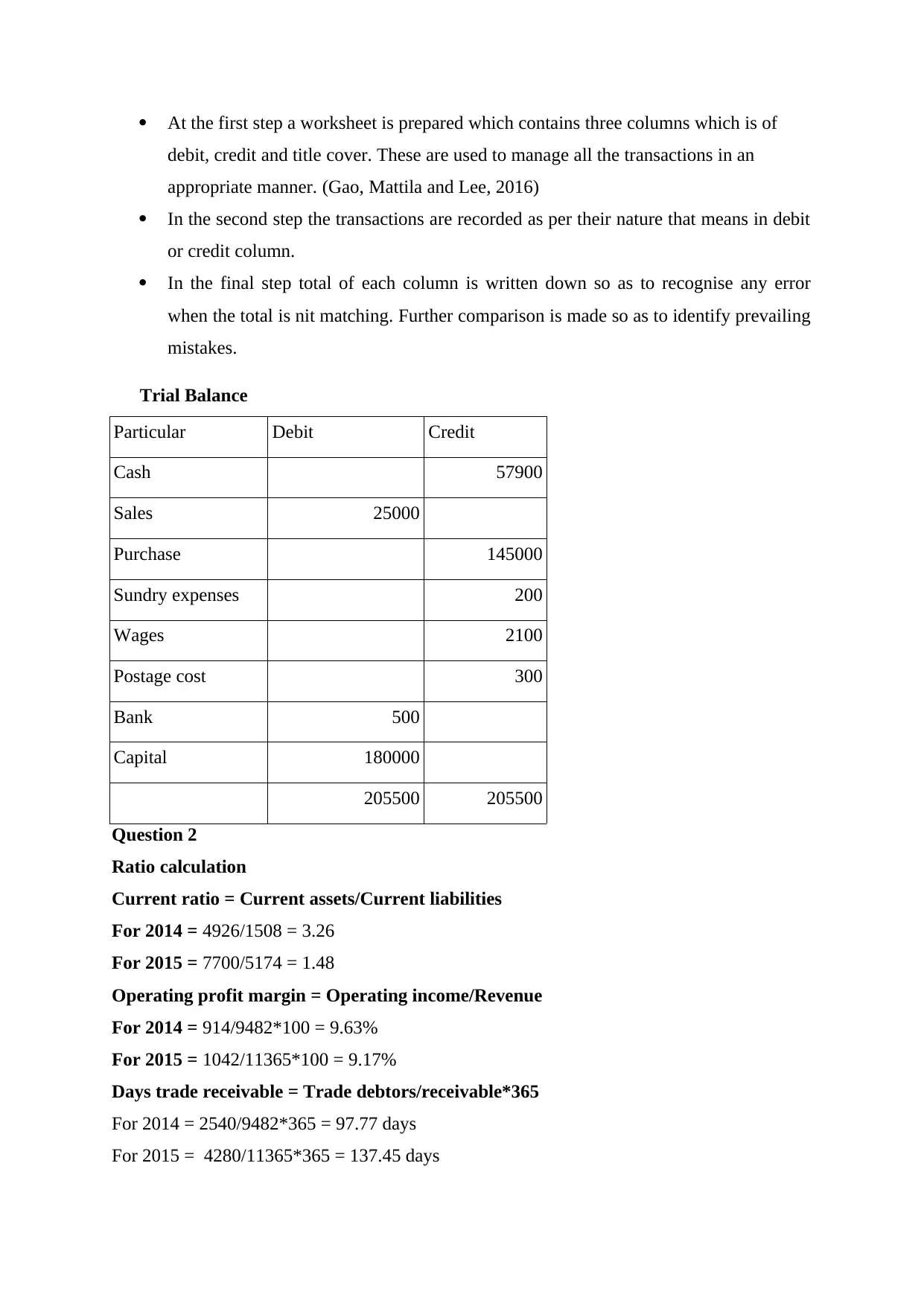
At the first step a worksheet is prepared which contains three columns which is of
debit, credit and title cover. These are used to manage all the transactions in an
appropriate manner. (Gao, Mattila and Lee, 2016)
In the second step the transactions are recorded as per their nature that means in debit
or credit column.
In the final step total of each column is written down so as to recognise any error
when the total is nit matching. Further comparison is made so as to identify prevailing
mistakes.
Trial Balance
Particular Debit Credit
Cash 57900
Sales 25000
Purchase 145000
Sundry expenses 200
Wages 2100
Postage cost 300
Bank 500
Capital 180000
205500 205500
Question 2
Ratio calculation
Current ratio = Current assets/Current liabilities
For 2014 = 4926/1508 = 3.26
For 2015 = 7700/5174 = 1.48
Operating profit margin = Operating income/Revenue
For 2014 = 914/9482*100 = 9.63%
For 2015 = 1042/11365*100 = 9.17%
Days trade receivable = Trade debtors/receivable*365
For 2014 = 2540/9482*365 = 97.77 days
For 2015 = 4280/11365*365 = 137.45 days
debit, credit and title cover. These are used to manage all the transactions in an
appropriate manner. (Gao, Mattila and Lee, 2016)
In the second step the transactions are recorded as per their nature that means in debit
or credit column.
In the final step total of each column is written down so as to recognise any error
when the total is nit matching. Further comparison is made so as to identify prevailing
mistakes.
Trial Balance
Particular Debit Credit
Cash 57900
Sales 25000
Purchase 145000
Sundry expenses 200
Wages 2100
Postage cost 300
Bank 500
Capital 180000
205500 205500
Question 2
Ratio calculation
Current ratio = Current assets/Current liabilities
For 2014 = 4926/1508 = 3.26
For 2015 = 7700/5174 = 1.48
Operating profit margin = Operating income/Revenue
For 2014 = 914/9482*100 = 9.63%
For 2015 = 1042/11365*100 = 9.17%
Days trade receivable = Trade debtors/receivable*365
For 2014 = 2540/9482*365 = 97.77 days
For 2015 = 4280/11365*365 = 137.45 days
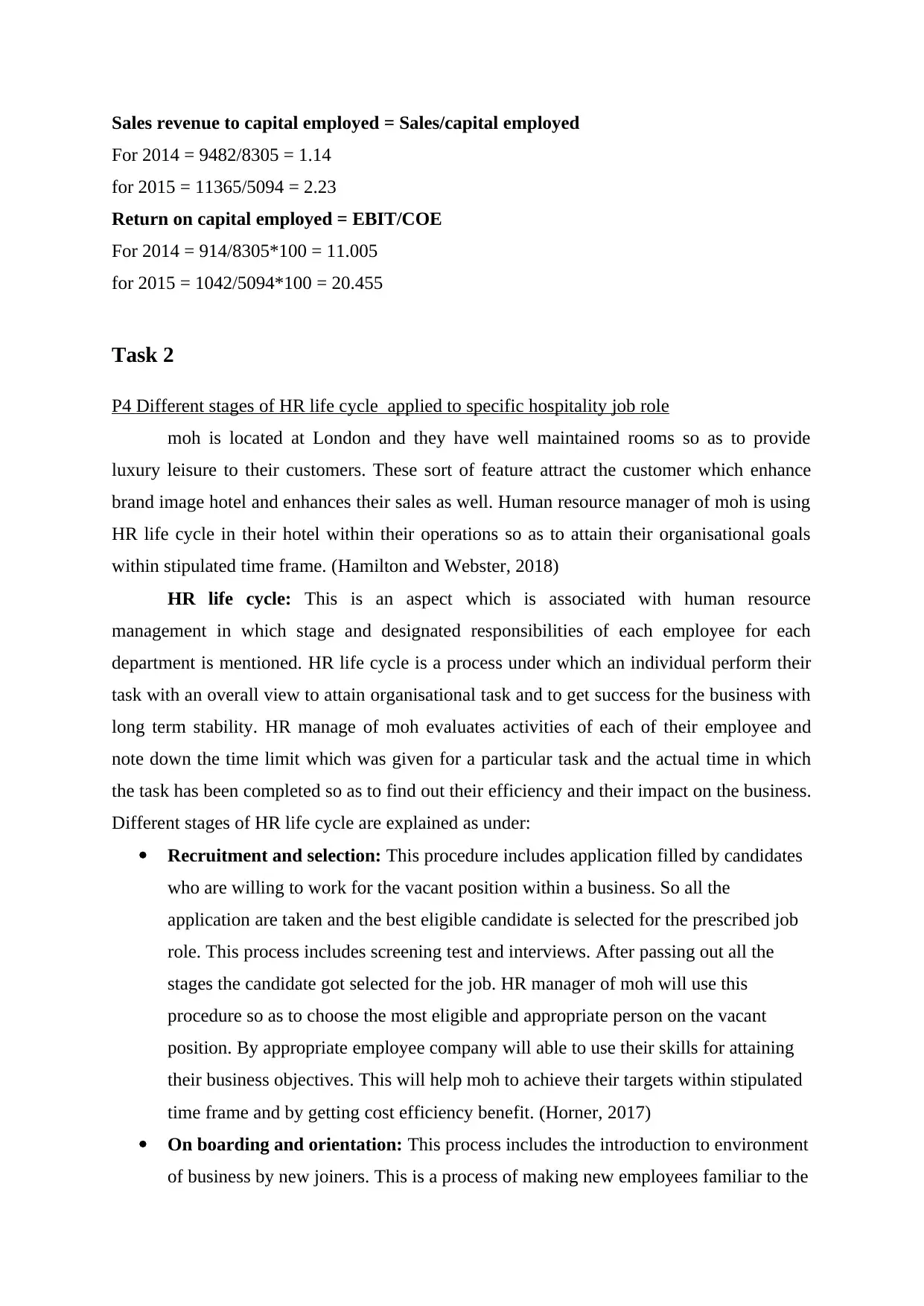
Sales revenue to capital employed = Sales/capital employed
For 2014 = 9482/8305 = 1.14
for 2015 = 11365/5094 = 2.23
Return on capital employed = EBIT/COE
For 2014 = 914/8305*100 = 11.005
for 2015 = 1042/5094*100 = 20.455
Task 2
P4 Different stages of HR life cycle applied to specific hospitality job role
moh is located at London and they have well maintained rooms so as to provide
luxury leisure to their customers. These sort of feature attract the customer which enhance
brand image hotel and enhances their sales as well. Human resource manager of moh is using
HR life cycle in their hotel within their operations so as to attain their organisational goals
within stipulated time frame. (Hamilton and Webster, 2018)
HR life cycle: This is an aspect which is associated with human resource
management in which stage and designated responsibilities of each employee for each
department is mentioned. HR life cycle is a process under which an individual perform their
task with an overall view to attain organisational task and to get success for the business with
long term stability. HR manage of moh evaluates activities of each of their employee and
note down the time limit which was given for a particular task and the actual time in which
the task has been completed so as to find out their efficiency and their impact on the business.
Different stages of HR life cycle are explained as under:
Recruitment and selection: This procedure includes application filled by candidates
who are willing to work for the vacant position within a business. So all the
application are taken and the best eligible candidate is selected for the prescribed job
role. This process includes screening test and interviews. After passing out all the
stages the candidate got selected for the job. HR manager of moh will use this
procedure so as to choose the most eligible and appropriate person on the vacant
position. By appropriate employee company will able to use their skills for attaining
their business objectives. This will help moh to achieve their targets within stipulated
time frame and by getting cost efficiency benefit. (Horner, 2017)
On boarding and orientation: This process includes the introduction to environment
of business by new joiners. This is a process of making new employees familiar to the
For 2014 = 9482/8305 = 1.14
for 2015 = 11365/5094 = 2.23
Return on capital employed = EBIT/COE
For 2014 = 914/8305*100 = 11.005
for 2015 = 1042/5094*100 = 20.455
Task 2
P4 Different stages of HR life cycle applied to specific hospitality job role
moh is located at London and they have well maintained rooms so as to provide
luxury leisure to their customers. These sort of feature attract the customer which enhance
brand image hotel and enhances their sales as well. Human resource manager of moh is using
HR life cycle in their hotel within their operations so as to attain their organisational goals
within stipulated time frame. (Hamilton and Webster, 2018)
HR life cycle: This is an aspect which is associated with human resource
management in which stage and designated responsibilities of each employee for each
department is mentioned. HR life cycle is a process under which an individual perform their
task with an overall view to attain organisational task and to get success for the business with
long term stability. HR manage of moh evaluates activities of each of their employee and
note down the time limit which was given for a particular task and the actual time in which
the task has been completed so as to find out their efficiency and their impact on the business.
Different stages of HR life cycle are explained as under:
Recruitment and selection: This procedure includes application filled by candidates
who are willing to work for the vacant position within a business. So all the
application are taken and the best eligible candidate is selected for the prescribed job
role. This process includes screening test and interviews. After passing out all the
stages the candidate got selected for the job. HR manager of moh will use this
procedure so as to choose the most eligible and appropriate person on the vacant
position. By appropriate employee company will able to use their skills for attaining
their business objectives. This will help moh to achieve their targets within stipulated
time frame and by getting cost efficiency benefit. (Horner, 2017)
On boarding and orientation: This process includes the introduction to environment
of business by new joiners. This is a process of making new employees familiar to the
⊘ This is a preview!⊘
Do you want full access?
Subscribe today to unlock all pages.

Trusted by 1+ million students worldwide
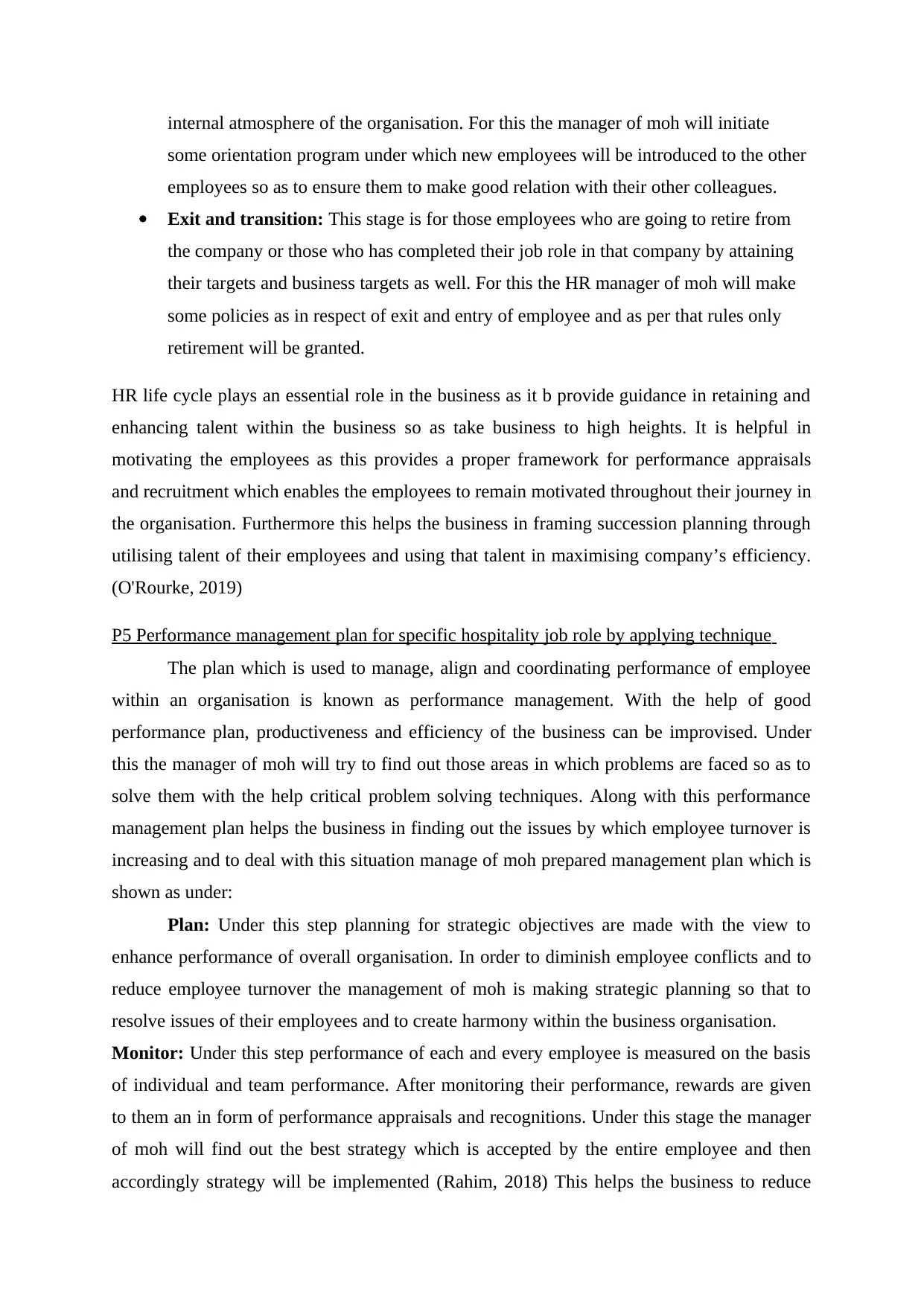
internal atmosphere of the organisation. For this the manager of moh will initiate
some orientation program under which new employees will be introduced to the other
employees so as to ensure them to make good relation with their other colleagues.
Exit and transition: This stage is for those employees who are going to retire from
the company or those who has completed their job role in that company by attaining
their targets and business targets as well. For this the HR manager of moh will make
some policies as in respect of exit and entry of employee and as per that rules only
retirement will be granted.
HR life cycle plays an essential role in the business as it b provide guidance in retaining and
enhancing talent within the business so as take business to high heights. It is helpful in
motivating the employees as this provides a proper framework for performance appraisals
and recruitment which enables the employees to remain motivated throughout their journey in
the organisation. Furthermore this helps the business in framing succession planning through
utilising talent of their employees and using that talent in maximising company’s efficiency.
(O'Rourke, 2019)
P5 Performance management plan for specific hospitality job role by applying technique
The plan which is used to manage, align and coordinating performance of employee
within an organisation is known as performance management. With the help of good
performance plan, productiveness and efficiency of the business can be improvised. Under
this the manager of moh will try to find out those areas in which problems are faced so as to
solve them with the help critical problem solving techniques. Along with this performance
management plan helps the business in finding out the issues by which employee turnover is
increasing and to deal with this situation manage of moh prepared management plan which is
shown as under:
Plan: Under this step planning for strategic objectives are made with the view to
enhance performance of overall organisation. In order to diminish employee conflicts and to
reduce employee turnover the management of moh is making strategic planning so that to
resolve issues of their employees and to create harmony within the business organisation.
Monitor: Under this step performance of each and every employee is measured on the basis
of individual and team performance. After monitoring their performance, rewards are given
to them an in form of performance appraisals and recognitions. Under this stage the manager
of moh will find out the best strategy which is accepted by the entire employee and then
accordingly strategy will be implemented (Rahim, 2018) This helps the business to reduce
some orientation program under which new employees will be introduced to the other
employees so as to ensure them to make good relation with their other colleagues.
Exit and transition: This stage is for those employees who are going to retire from
the company or those who has completed their job role in that company by attaining
their targets and business targets as well. For this the HR manager of moh will make
some policies as in respect of exit and entry of employee and as per that rules only
retirement will be granted.
HR life cycle plays an essential role in the business as it b provide guidance in retaining and
enhancing talent within the business so as take business to high heights. It is helpful in
motivating the employees as this provides a proper framework for performance appraisals
and recruitment which enables the employees to remain motivated throughout their journey in
the organisation. Furthermore this helps the business in framing succession planning through
utilising talent of their employees and using that talent in maximising company’s efficiency.
(O'Rourke, 2019)
P5 Performance management plan for specific hospitality job role by applying technique
The plan which is used to manage, align and coordinating performance of employee
within an organisation is known as performance management. With the help of good
performance plan, productiveness and efficiency of the business can be improvised. Under
this the manager of moh will try to find out those areas in which problems are faced so as to
solve them with the help critical problem solving techniques. Along with this performance
management plan helps the business in finding out the issues by which employee turnover is
increasing and to deal with this situation manage of moh prepared management plan which is
shown as under:
Plan: Under this step planning for strategic objectives are made with the view to
enhance performance of overall organisation. In order to diminish employee conflicts and to
reduce employee turnover the management of moh is making strategic planning so that to
resolve issues of their employees and to create harmony within the business organisation.
Monitor: Under this step performance of each and every employee is measured on the basis
of individual and team performance. After monitoring their performance, rewards are given
to them an in form of performance appraisals and recognitions. Under this stage the manager
of moh will find out the best strategy which is accepted by the entire employee and then
accordingly strategy will be implemented (Rahim, 2018) This helps the business to reduce
Paraphrase This Document
Need a fresh take? Get an instant paraphrase of this document with our AI Paraphraser
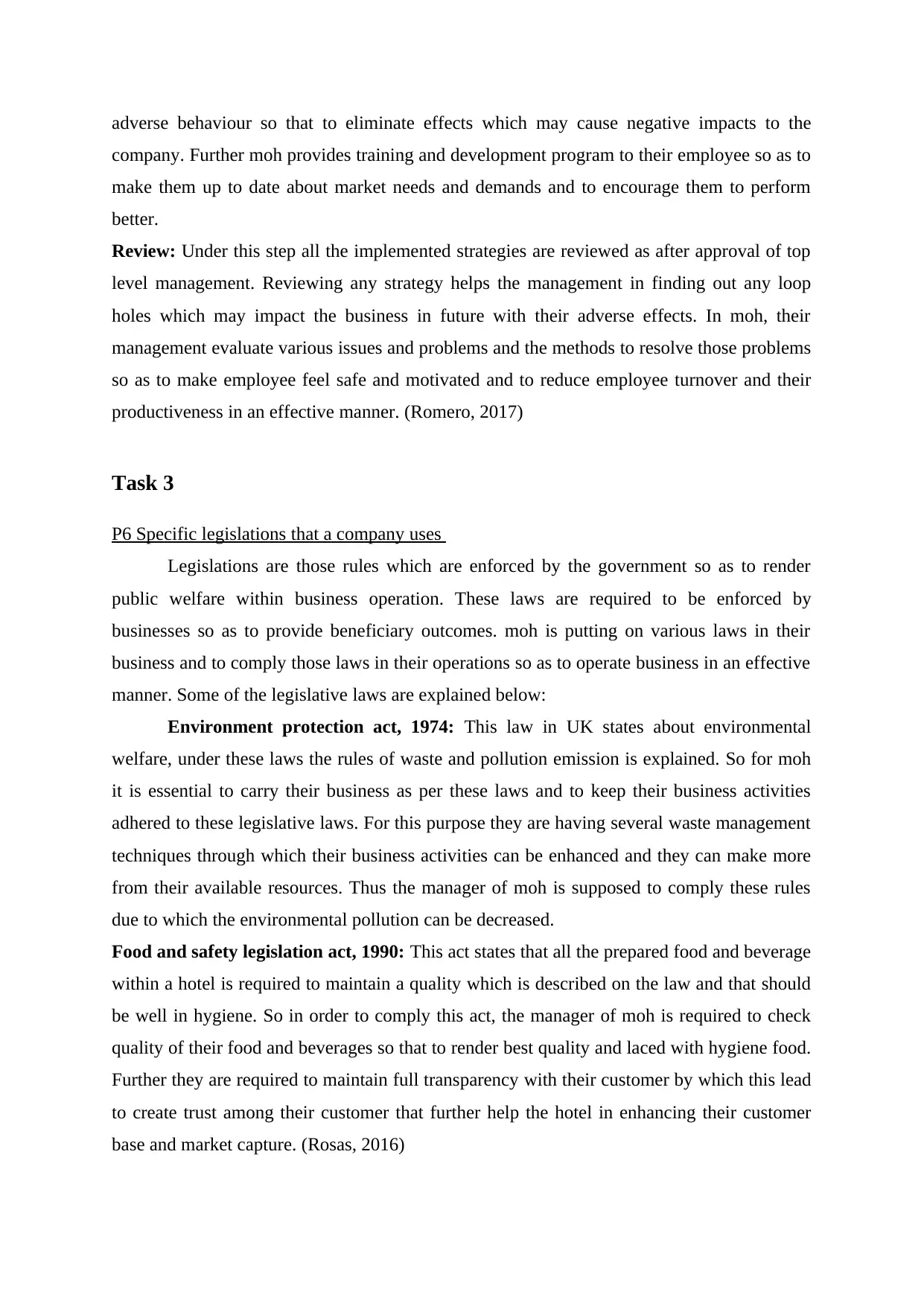
adverse behaviour so that to eliminate effects which may cause negative impacts to the
company. Further moh provides training and development program to their employee so as to
make them up to date about market needs and demands and to encourage them to perform
better.
Review: Under this step all the implemented strategies are reviewed as after approval of top
level management. Reviewing any strategy helps the management in finding out any loop
holes which may impact the business in future with their adverse effects. In moh, their
management evaluate various issues and problems and the methods to resolve those problems
so as to make employee feel safe and motivated and to reduce employee turnover and their
productiveness in an effective manner. (Romero, 2017)
Task 3
P6 Specific legislations that a company uses
Legislations are those rules which are enforced by the government so as to render
public welfare within business operation. These laws are required to be enforced by
businesses so as to provide beneficiary outcomes. moh is putting on various laws in their
business and to comply those laws in their operations so as to operate business in an effective
manner. Some of the legislative laws are explained below:
Environment protection act, 1974: This law in UK states about environmental
welfare, under these laws the rules of waste and pollution emission is explained. So for moh
it is essential to carry their business as per these laws and to keep their business activities
adhered to these legislative laws. For this purpose they are having several waste management
techniques through which their business activities can be enhanced and they can make more
from their available resources. Thus the manager of moh is supposed to comply these rules
due to which the environmental pollution can be decreased.
Food and safety legislation act, 1990: This act states that all the prepared food and beverage
within a hotel is required to maintain a quality which is described on the law and that should
be well in hygiene. So in order to comply this act, the manager of moh is required to check
quality of their food and beverages so that to render best quality and laced with hygiene food.
Further they are required to maintain full transparency with their customer by which this lead
to create trust among their customer that further help the hotel in enhancing their customer
base and market capture. (Rosas, 2016)
company. Further moh provides training and development program to their employee so as to
make them up to date about market needs and demands and to encourage them to perform
better.
Review: Under this step all the implemented strategies are reviewed as after approval of top
level management. Reviewing any strategy helps the management in finding out any loop
holes which may impact the business in future with their adverse effects. In moh, their
management evaluate various issues and problems and the methods to resolve those problems
so as to make employee feel safe and motivated and to reduce employee turnover and their
productiveness in an effective manner. (Romero, 2017)
Task 3
P6 Specific legislations that a company uses
Legislations are those rules which are enforced by the government so as to render
public welfare within business operation. These laws are required to be enforced by
businesses so as to provide beneficiary outcomes. moh is putting on various laws in their
business and to comply those laws in their operations so as to operate business in an effective
manner. Some of the legislative laws are explained below:
Environment protection act, 1974: This law in UK states about environmental
welfare, under these laws the rules of waste and pollution emission is explained. So for moh
it is essential to carry their business as per these laws and to keep their business activities
adhered to these legislative laws. For this purpose they are having several waste management
techniques through which their business activities can be enhanced and they can make more
from their available resources. Thus the manager of moh is supposed to comply these rules
due to which the environmental pollution can be decreased.
Food and safety legislation act, 1990: This act states that all the prepared food and beverage
within a hotel is required to maintain a quality which is described on the law and that should
be well in hygiene. So in order to comply this act, the manager of moh is required to check
quality of their food and beverages so that to render best quality and laced with hygiene food.
Further they are required to maintain full transparency with their customer by which this lead
to create trust among their customer that further help the hotel in enhancing their customer
base and market capture. (Rosas, 2016)
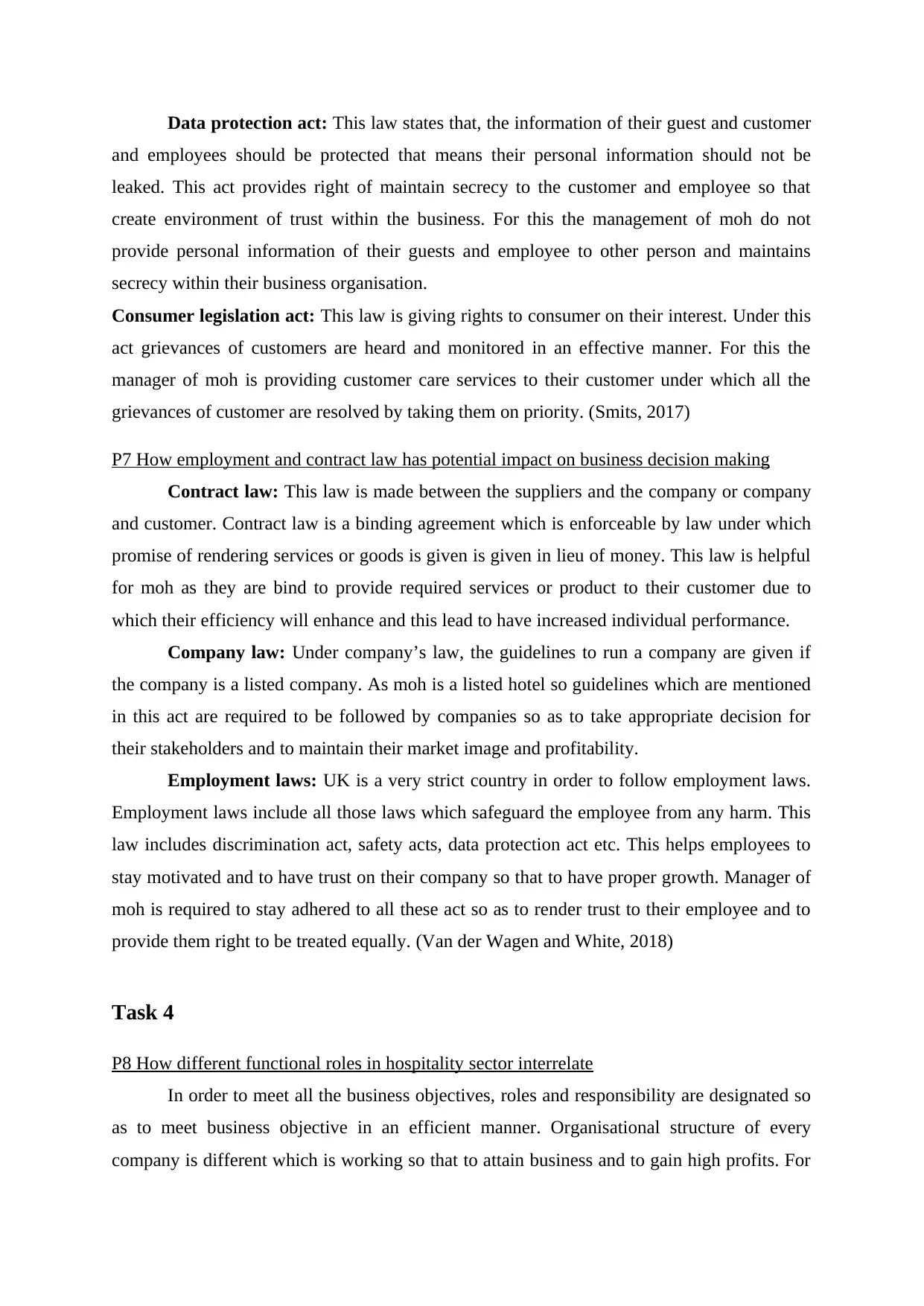
Data protection act: This law states that, the information of their guest and customer
and employees should be protected that means their personal information should not be
leaked. This act provides right of maintain secrecy to the customer and employee so that
create environment of trust within the business. For this the management of moh do not
provide personal information of their guests and employee to other person and maintains
secrecy within their business organisation.
Consumer legislation act: This law is giving rights to consumer on their interest. Under this
act grievances of customers are heard and monitored in an effective manner. For this the
manager of moh is providing customer care services to their customer under which all the
grievances of customer are resolved by taking them on priority. (Smits, 2017)
P7 How employment and contract law has potential impact on business decision making
Contract law: This law is made between the suppliers and the company or company
and customer. Contract law is a binding agreement which is enforceable by law under which
promise of rendering services or goods is given is given in lieu of money. This law is helpful
for moh as they are bind to provide required services or product to their customer due to
which their efficiency will enhance and this lead to have increased individual performance.
Company law: Under company’s law, the guidelines to run a company are given if
the company is a listed company. As moh is a listed hotel so guidelines which are mentioned
in this act are required to be followed by companies so as to take appropriate decision for
their stakeholders and to maintain their market image and profitability.
Employment laws: UK is a very strict country in order to follow employment laws.
Employment laws include all those laws which safeguard the employee from any harm. This
law includes discrimination act, safety acts, data protection act etc. This helps employees to
stay motivated and to have trust on their company so that to have proper growth. Manager of
moh is required to stay adhered to all these act so as to render trust to their employee and to
provide them right to be treated equally. (Van der Wagen and White, 2018)
Task 4
P8 How different functional roles in hospitality sector interrelate
In order to meet all the business objectives, roles and responsibility are designated so
as to meet business objective in an efficient manner. Organisational structure of every
company is different which is working so that to attain business and to gain high profits. For
and employees should be protected that means their personal information should not be
leaked. This act provides right of maintain secrecy to the customer and employee so that
create environment of trust within the business. For this the management of moh do not
provide personal information of their guests and employee to other person and maintains
secrecy within their business organisation.
Consumer legislation act: This law is giving rights to consumer on their interest. Under this
act grievances of customers are heard and monitored in an effective manner. For this the
manager of moh is providing customer care services to their customer under which all the
grievances of customer are resolved by taking them on priority. (Smits, 2017)
P7 How employment and contract law has potential impact on business decision making
Contract law: This law is made between the suppliers and the company or company
and customer. Contract law is a binding agreement which is enforceable by law under which
promise of rendering services or goods is given is given in lieu of money. This law is helpful
for moh as they are bind to provide required services or product to their customer due to
which their efficiency will enhance and this lead to have increased individual performance.
Company law: Under company’s law, the guidelines to run a company are given if
the company is a listed company. As moh is a listed hotel so guidelines which are mentioned
in this act are required to be followed by companies so as to take appropriate decision for
their stakeholders and to maintain their market image and profitability.
Employment laws: UK is a very strict country in order to follow employment laws.
Employment laws include all those laws which safeguard the employee from any harm. This
law includes discrimination act, safety acts, data protection act etc. This helps employees to
stay motivated and to have trust on their company so that to have proper growth. Manager of
moh is required to stay adhered to all these act so as to render trust to their employee and to
provide them right to be treated equally. (Van der Wagen and White, 2018)
Task 4
P8 How different functional roles in hospitality sector interrelate
In order to meet all the business objectives, roles and responsibility are designated so
as to meet business objective in an efficient manner. Organisational structure of every
company is different which is working so that to attain business and to gain high profits. For
⊘ This is a preview!⊘
Do you want full access?
Subscribe today to unlock all pages.

Trusted by 1+ million students worldwide
1 out of 16
Related Documents
Your All-in-One AI-Powered Toolkit for Academic Success.
+13062052269
info@desklib.com
Available 24*7 on WhatsApp / Email
![[object Object]](/_next/static/media/star-bottom.7253800d.svg)
Unlock your academic potential
Copyright © 2020–2025 A2Z Services. All Rights Reserved. Developed and managed by ZUCOL.





